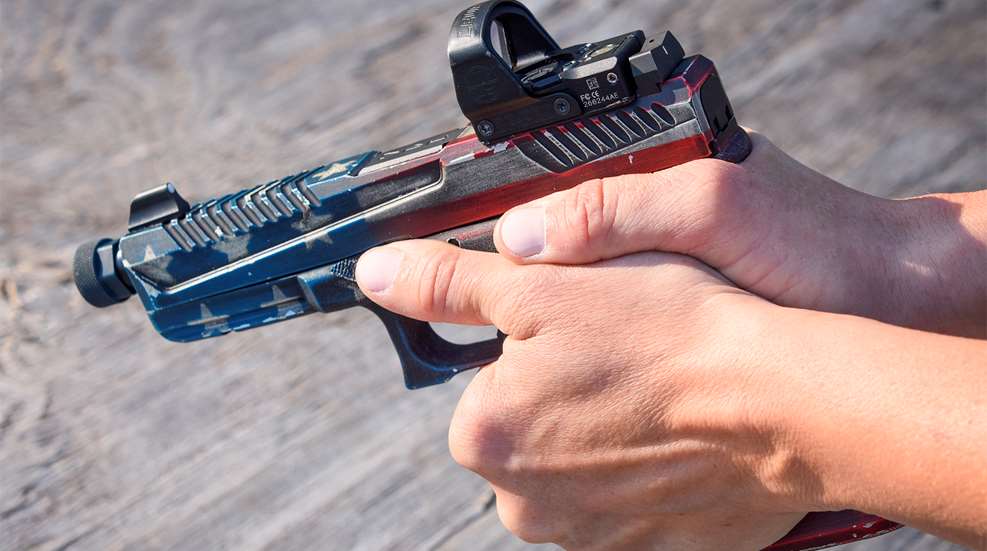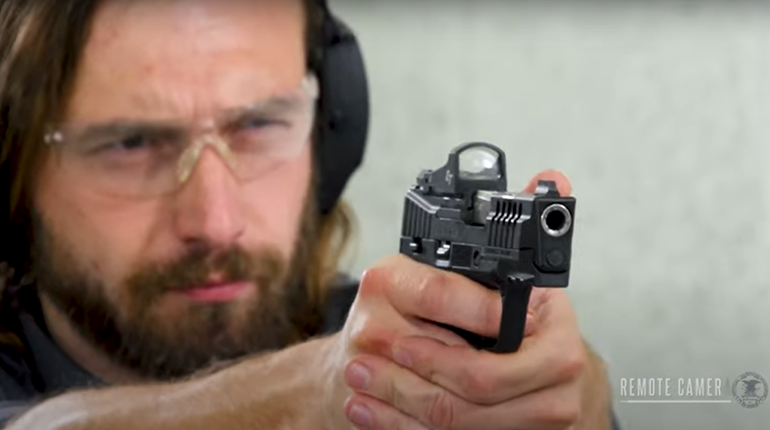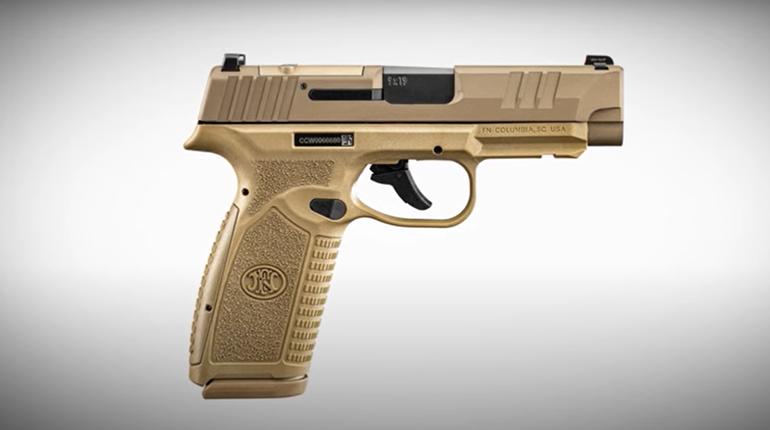
Every human being is different, physically and mentally. We have different strengths and weaknesses, and one of these is that women tend to be physically smaller than men. This can play a role in shooting a firearm that is suited for the “average” size human, which is not necessarily smaller sized women.
While we may not typically be the largest and strongest, women can apply the same principles and mechanics as any other person to achieve control of a firearm. Properly performed, grip mechanics can overcome strength issues. Knowing how to apply a strong grip can mean the difference between tolerating shooting a firearm and enjoying it. For those who might help women learn to shoot consider it your job to help others understand these principles. You will reinforce good habits by helping others learn them from the start.

Semi-automatic Pistol
How you grip the gun varies, and depends on the type of gun that you have. For a basic semi-automatic pistol, you want to apply several tactics to build a strong grip.
Start by placing your shooting hand, the hand that you will pull the trigger with, as high on the backstrap as you can. This puts more of the “mass” of your body physically behind the reciprocating part of the pistol, the slide. As the slide moves back when you fire, it needs to go all the way back, stop and then start moving forward. In that movement the empty case is ejected and a new round stripped out of the magazine and loaded into the chamber, and as the slide closes, you prepare to shoot again. If you are “soft” or don’t have enough power to hold the frame of the gun (the lower part) still as the slide reciprocates, it can malfunction. It will also allow the muzzle to flip up and back, which means you will have to apply more movement to get the gun back on target.
You want it to feel like there’s zero space left, and the web of your thumb is squished into the beavertail or top of the backstrap. You can see how this feels with an empty gun by having a partner cycle the slide. Experiment with your hand lower, and see what happens when your partner pulls the slide back and you are holding too low. You can even use this exercise to check your stance ... if your toes come off the ground when they hand-cycle the slide, you need to get more aggressive in your stance and shift your weight forward.
Once your dominant/shooting hand is in place, you want to be aware of how hard and what direction you are gripping with your fingers and the rest of your hand. You want the pressure that you use to grip the gun to come from the front of the grip to the back—straight front-to-back pressure. This helps you avoid pressure in your fingertips, because the pressure in one finger plays a role in your sympathetic nervous system and will manifest as pressure in all your fingers. That can cause you to pull the trigger with your entire hand moving, and the shots can be “pulled” off the target when you shoot.

Place your support or non-dominant hand onto the grip so that you get as much of the “meaty” part of your palm (behind your thumb) onto the backstrap as possible. It might be very little, but it will help you to get as much of your hand in contact with the actual grip as possible. As you do this, you want to connect your palms so that there is no gap between them. If you see a gap, you need to adjust.
As you place your palm, be aware of your support hand thumb and where it sits. You want to rest it along the frame and not on the slide. If you let your thumb rest on the slide, it can induce a malfunction by slowing the slide down. You don’t want this, especially in a self-defense scenario.
As your support hand joins your dominant hand and both hands hold the grip, focus on trying to maintain that front-to-back pressure in both hands. You can also add a sort of “clamshell” pressure where the heels of your hands/palms meet. This will add to your ability to create a solid presence behind the gun, and the reciprocating slide can cycle and return and you will be able to keep the gun and sights on target more effectively, with less time required to steer the gun and sights back onto target between shots.

The last item I want to touch on is not actually part of your grip, but concerns the muscles in your shoulders and engaging them. In many sports, you hear the term, “functional tension.” This means that you do not stand like a limp noodle, waiting for forces to act on your body, but you hold tension. When you ski, it's what you feel pulling your legs back underneath your body. When you play volleyball or basketball and are low and ready to react, it’s the tension in your calves, quads and legs as you are waiting to react. Shooting is the same. One of the places that functional tension is most helpful in shooting a pistol is in how you hold your shoulders. You can imagine a string from the ceiling to your front sight, and you want to pull down on that string. You will feel tension in your shoulders. You can also find this by working with a partner and having them push up on the front of your pistol, while you counter it with downward force. That will engage those muscles in your shoulders and that will help your body to counter the recoil when you shoot.

Revolver
Shooting a revolver will require some modification of the above grip principles. You want to keep your hands and fingers away from the rotating cylinder and any gasses expelled around the gap between the revolver’s frame and cylinder.
The actual grip of a revolver is different from the grip of a semi-automatic pistol in its construction. Often they are smaller in diameter, which is one reason some people suggest them to women. You are only going to be able to get your hands so high on the backstrap of a revolver, due to the need for the hammer to be cocked and move. When you grab onto a revolver to build your grip, get your hand as high as you can so that you are behind the gun, the idea being for the revolver to recoil straight back and your body to be straight behind it, giving as much physical mass as you can to control the recoil. Wrap your thumbs over each other to keep them away from the cylinder.
I actually prefer a semi-auto pistol to a revolver for a few reasons. For one, I can’t get my grip as high on a revolver. They also require more practice to become efficient in, and hold fewer rounds and take longer to reload.


Adjustments
If your hands are very small or you have short fingers, you might not have your fingers in the same place as someone else. That’s OK, as long as your modification keeps your hands safe! Everyone has different hand sizes so not all grips are the same. Applying the correct principles will help you to properly grip and control a pistol, but everyone’s unique physical make-up means we might each need to adapt the “how” to what our bodies can physically do.
As always, any practice with an empty gun should always be done with unloaded guns and no ammunition present. Check that your guns are clear before you begin and follow the rules of firearms safety.















































